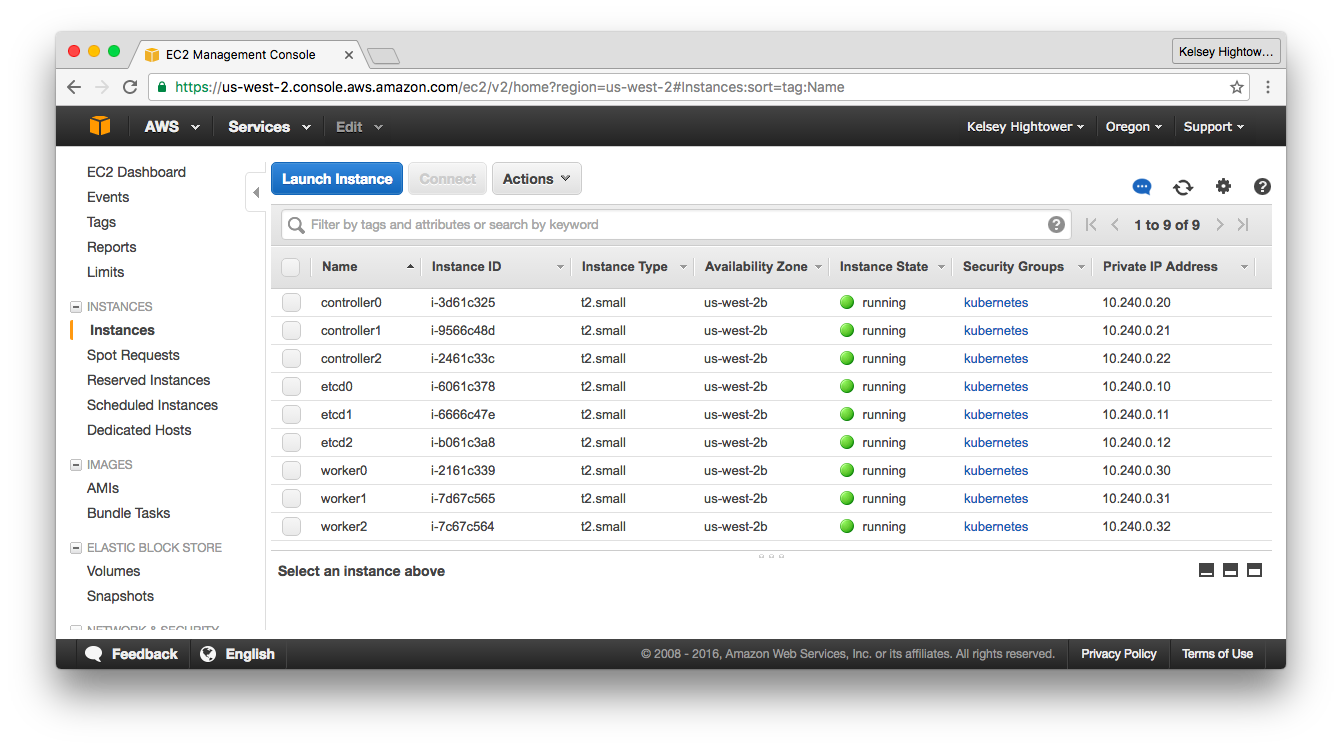9.9 KiB
Cloud Infrastructure Provisioning - Amazon Web Services
This lab will walk you through provisioning the compute instances required for running a H/A Kubernetes cluster. A total of 9 virtual machines will be created.
After completing this guide you should have the following compute instances:
All machines will be provisioned with fixed private IP addresses to simplify the bootstrap process.
To make our Kubernetes control plane remotely accessible, a public IP address will be provisioned and assigned to a Load Balancer that will sit in front of the 3 Kubernetes controllers.
Create a Custom Network
VPC_ID=$(aws ec2 create-vpc \
--cidr-block 10.240.0.0/16 | \
jq -r '.Vpc.VpcId')
aws ec2 modify-vpc-attribute \
--vpc-id ${VPC_ID} \
--enable-dns-support '{"Value": true}'
aws ec2 modify-vpc-attribute \
--vpc-id ${VPC_ID} \
--enable-dns-hostnames '{"Value": true}'
DHCP_OPTION_SET_ID=$(aws ec2 create-dhcp-options \
--dhcp-configuration "Key=domain-name,Values=us-west-2.compute.internal" \
"Key=domain-name-servers,Values=AmazonProvidedDNS" | \
jq -r '.DhcpOptions.DhcpOptionsId')
aws ec2 associate-dhcp-options \
--dhcp-options-id ${DHCP_OPTION_SET_ID} \
--vpc-id ${VPC_ID}
Create a subnet for the Kubernetes cluster:
SUBNET_ID=$(aws ec2 create-subnet \
--vpc-id ${VPC_ID} \
--cidr-block 10.240.0.0/24 | \
jq -r '.Subnet.SubnetId')
Create an internet gateway
INTERNET_GATEWAY_ID=$(aws ec2 create-internet-gateway | \
jq -r '.InternetGateway.InternetGatewayId')
aws ec2 attach-internet-gateway \
--internet-gateway-id ${INTERNET_GATEWAY_ID} \
--vpc-id ${VPC_ID}
Route Table
ROUTE_TABLE_ID=$(aws ec2 create-route-table \
--vpc-id ${VPC_ID} | \
jq -r '.RouteTable.RouteTableId')
aws ec2 associate-route-table \
--route-table-id ${ROUTE_TABLE_ID} \
--subnet-id ${SUBNET_ID}
aws ec2 create-route \
--route-table-id ${ROUTE_TABLE_ID} \
--destination-cidr-block 0.0.0.0/0 \
--gateway-id ${INTERNET_GATEWAY_ID}
Firewall Rules
SECURITY_GROUP_ID=$(aws ec2 create-security-group \
--group-name kubernetes \
--description "Kubernetes security group" \
--vpc-id ${VPC_ID} | \
jq -r '.GroupId')
aws ec2 authorize-security-group-ingress \
--group-id ${SECURITY_GROUP_ID} \
--protocol all
aws ec2 authorize-security-group-ingress \
--group-id ${SECURITY_GROUP_ID} \
--protocol all \
--port 0-65535 \
--cidr 10.240.0.0/16
aws ec2 authorize-security-group-ingress \
--group-id ${SECURITY_GROUP_ID} \
--protocol tcp \
--port 22 \
--cidr 0.0.0.0/0
aws ec2 authorize-security-group-ingress \
--group-id ${SECURITY_GROUP_ID} \
--protocol tcp \
--port 443 \
--cidr 0.0.0.0/0
Create the Kubernetes Public IP Address
Create a public IP address that will be used by remote clients to connect to the Kubernetes control plane:
aws elb create-load-balancer \
--load-balancer-name kubernetes \
--listeners "Protocol=TCP,LoadBalancerPort=6443,InstanceProtocol=TCP,InstancePort=6443" \
--subnets ${SUBNET_ID} \
--security-groups ${SECURITY_GROUP_ID}
KUBERNETES_PUBLIC_IP_ADDRESS=$(aws elb describe-load-balancers \
--load-balancer-name kubernetes | \
jq -r '.LoadBalancerDescriptions[].DNSName')
Provision Virtual Machines
All the VMs in this lab will be provisioned using Ubuntu 16.04 mainly because it runs a newish Linux Kernel that has good support for Docker.
Create Instance IAM Policies
cat > kubernetes-iam-role.json <<'EOF'
{
"Version": "2012-10-17",
"Statement": [
{"Effect": "Allow", "Principal": { "Service": "ec2.amazonaws.com"}, "Action": "sts:AssumeRole"}
]
}
EOF
aws iam create-role \
--role-name kubernetes \
--assume-role-policy-document file://kubernetes-iam-role.json
cat > kubernetes-iam-policy.json <<'EOF'
{
"Version": "2012-10-17",
"Statement": [
{"Effect": "Allow", "Action": ["ec2:*"], "Resource": ["*"]},
{"Effect": "Allow", "Action": ["elasticloadbalancing:*"], "Resource": ["*"]},
{"Effect": "Allow", "Action": ["route53:*"], "Resource": ["*"]},
{"Effect": "Allow", "Action": ["ecr:*"], "Resource": "*"}
]
}
EOF
aws iam put-role-policy \
--role-name kubernetes \
--policy-name kubernetes \
--policy-document file://kubernetes-iam-policy.json
aws iam create-instance-profile \
--instance-profile-name kubernetes
aws iam add-role-to-instance-profile \
--instance-profile-name kubernetes \
--role-name kubernetes
Chosing an Image
Use the Ubuntu Amazon EC2 AMI Locator to find the right image-id for your zone. This guide assumes the us-west-2 zone.
IMAGE_ID="ami-746aba14"
Generate A SSH Key Pair
aws ec2 create-key-pair --key-name kubernetes | \
jq -r '.KeyMaterial' > ~/.ssh/kubernetes_the_hard_way
chmod 600 ~/.ssh/kubernetes_the_hard_way
ssh-add ~/.ssh/kubernetes_the_hard_way
etcd
ETCD_0_INSTANCE_ID=$(aws ec2 run-instances \
--associate-public-ip-address \
--image-id ${IMAGE_ID} \
--count 1 \
--key-name kubernetes \
--security-group-ids ${SECURITY_GROUP_ID} \
--instance-type t2.small \
--private-ip-address 10.240.0.10 \
--subnet-id ${SUBNET_ID} | \
jq -r '.Instances[].InstanceId')
aws ec2 create-tags \
--resources ${ETCD_0_INSTANCE_ID} \
--tags Key=Name,Value=etcd0
ETCD_1_INSTANCE_ID=$(aws ec2 run-instances \
--associate-public-ip-address \
--image-id ${IMAGE_ID} \
--count 1 \
--key-name kubernetes \
--security-group-ids ${SECURITY_GROUP_ID} \
--instance-type t2.small \
--private-ip-address 10.240.0.11 \
--subnet-id ${SUBNET_ID} | \
jq -r '.Instances[].InstanceId')
aws ec2 create-tags \
--resources ${ETCD_1_INSTANCE_ID} \
--tags Key=Name,Value=etcd1
ETCD_2_INSTANCE_ID=$(aws ec2 run-instances \
--associate-public-ip-address \
--image-id ${IMAGE_ID} \
--count 1 \
--key-name kubernetes \
--security-group-ids ${SECURITY_GROUP_ID} \
--instance-type t2.small \
--private-ip-address 10.240.0.12 \
--subnet-id ${SUBNET_ID} | \
jq -r '.Instances[].InstanceId')
aws ec2 create-tags \
--resources ${ETCD_2_INSTANCE_ID} \
--tags Key=Name,Value=etcd2
Kubernetes Controllers
CONTROLLER_0_INSTANCE_ID=$(aws ec2 run-instances \
--associate-public-ip-address \
--iam-instance-profile 'Name=kubernetes' \
--image-id ${IMAGE_ID} \
--count 1 \
--key-name kubernetes \
--security-group-ids ${SECURITY_GROUP_ID} \
--instance-type t2.small \
--private-ip-address 10.240.0.20 \
--subnet-id ${SUBNET_ID} | \
jq -r '.Instances[].InstanceId')
aws ec2 create-tags \
--resources ${CONTROLLER_0_INSTANCE_ID} \
--tags Key=Name,Value=controller0
CONTROLLER_1_INSTANCE_ID=$(aws ec2 run-instances \
--associate-public-ip-address \
--iam-instance-profile 'Name=kubernetes' \
--image-id ${IMAGE_ID} \
--count 1 \
--key-name kubernetes \
--security-group-ids ${SECURITY_GROUP_ID} \
--instance-type t2.small \
--private-ip-address 10.240.0.21 \
--subnet-id ${SUBNET_ID} | \
jq -r '.Instances[].InstanceId')
aws ec2 create-tags \
--resources ${CONTROLLER_1_INSTANCE_ID} \
--tags Key=Name,Value=controller1
CONTROLLER_2_INSTANCE_ID=$(aws ec2 run-instances \
--associate-public-ip-address \
--iam-instance-profile 'Name=kubernetes' \
--image-id ${IMAGE_ID} \
--count 1 \
--key-name kubernetes \
--security-group-ids ${SECURITY_GROUP_ID} \
--instance-type t2.small \
--private-ip-address 10.240.0.22 \
--subnet-id ${SUBNET_ID} | \
jq -r '.Instances[].InstanceId')
aws ec2 create-tags \
--resources ${CONTROLLER_2_INSTANCE_ID} \
--tags Key=Name,Value=controller2
Kubernetes Workers
WORKER_0_INSTANCE_ID=$(aws ec2 run-instances \
--associate-public-ip-address \
--iam-instance-profile 'Name=kubernetes' \
--image-id ${IMAGE_ID} \
--count 1 \
--key-name kubernetes \
--security-group-ids ${SECURITY_GROUP_ID} \
--instance-type t2.small \
--private-ip-address 10.240.0.30 \
--subnet-id ${SUBNET_ID} | \
jq -r '.Instances[].InstanceId')
aws ec2 create-tags \
--resources ${WORKER_0_INSTANCE_ID} \
--tags Key=Name,Value=worker0
WORKER_1_INSTANCE_ID=$(aws ec2 run-instances \
--associate-public-ip-address \
--iam-instance-profile 'Name=kubernetes' \
--image-id ${IMAGE_ID} \
--count 1 \
--key-name kubernetes \
--security-group-ids ${SECURITY_GROUP_ID} \
--instance-type t2.small \
--private-ip-address 10.240.0.31 \
--subnet-id ${SUBNET_ID} | \
jq -r '.Instances[].InstanceId')
aws ec2 create-tags \
--resources ${WORKER_1_INSTANCE_ID} \
--tags Key=Name,Value=worker1
WORKER_2_INSTANCE_ID=$(aws ec2 run-instances \
--associate-public-ip-address \
--iam-instance-profile 'Name=kubernetes' \
--image-id ${IMAGE_ID} \
--count 1 \
--key-name kubernetes \
--security-group-ids ${SECURITY_GROUP_ID} \
--instance-type t2.small \
--private-ip-address 10.240.0.32 \
--subnet-id ${SUBNET_ID} | \
jq -r '.Instances[].InstanceId')
aws ec2 create-tags \
--resources ${WORKER_2_INSTANCE_ID} \
--tags Key=Name,Value=worker2
Verify
aws ec2 describe-instances \
--filters "Name=instance-state-name,Values=running" | \
jq -j '.Reservations[].Instances[] | .InstanceId, " ", .Placement.AvailabilityZone, " ", .PrivateIpAddress, " ", .PublicIpAddress, "\n"'
i-f3714f2e us-west-2c 10.240.0.22 XX.XXX.XX.XX
i-ae714f73 us-west-2c 10.240.0.11 XX.XX.XX.XXX
i-f4714f29 us-west-2c 10.240.0.21 XX.XX.XXX.XXX
i-f6714f2b us-west-2c 10.240.0.12 XX.XX.XX.XX
i-e26e503f us-west-2c 10.240.0.30 XX.XX.XXX.XXX
i-e36e503e us-west-2c 10.240.0.31 XX.XX.XX.XX
i-e8714f35 us-west-2c 10.240.0.10 XX.XX.XXX.XXX
i-78704ea5 us-west-2c 10.240.0.20 XX.XX.XXX.XXX
i-4a6e5097 us-west-2c 10.240.0.32 XX.XX.XX.XX
